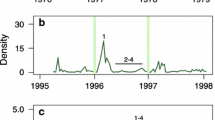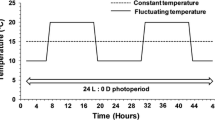Abstract
In this paper we discuss the effects of yearly temperature variation on the development and seasonal occurrence of poikiliothermic organisms with multiple life stages. The study of voltinism in the mountain pine beetle (Dendroctonus ponderosae Hopkins), an important forest insect living in extreme temperature environments and exhibiting no diapause, provides a motivational example. Using a minimal model for the rates of aging it is shown that seasonal temperature variation and minimal stage-specific differences in rates of aging are sufficient to create stable uni-and multi-voltine oviposition cycles. In fact, these cycles are attracting and therefore provide an exogenous mechanism for synchronizing whole populations of organisms. Structural stability arguments are used to extend the results to more general life systems.
Similar content being viewed by others
References
Amman, G. D. and W. E. Cole (1983). Mountain pine beetle dynamics in lodgepole pine forests. Part II. Population dynamics. USDA Forest Service GTR-INT-145, Ogden, Utah.
Arnold, V. I. and A. Avez (1968). Ergodic Problems of Classical Mechanics, New York: Benjamin.
Bentz, B. J., J. A. Logan and G. D. Amman (1991). Temperature-dependent development of the mountain pine beetle (Coleoptera: Scolytidae) and simulation of its phenology. Can. Entomol. 123, 1083–1094.
Danks, H. V. (1987). Insect Dormancy: An Ecological Prospective, Monograph Series 1, Ottawa: Biological Survey of Canada (Terrestrial Arthropods).
Guckenheimer, J. and P. Holmes (1983). Nonlinear Oscilations, Dynamical Systems, and Bifurcations of Vector Fields, 3rd edn, Berlin: Springer-Verlag.
Logan, J. A. (1988). Toward an expert system for development of pest simulation models. Environ. Entomol. 17, 359–376.
Logan, J. A. and G. D. Amman (1986). A distribution model for egg development in mountain pine beetle. Can. Entomol. 118, 361–372.
Logan, J. A. and B. J. Bentz (1999). Model analysis of mountain pine beetle (Coleoptera: Scolytidae) seasonality. Environ. Entomol. 28, 924–934.
Logan, J. A., D. J. Wollkind, S. C. Hoyt and L. K. Tanigoshi (1976). An analytic model for description of temperature dependent rate phenomena in arthropods. Environ. Entomol. 5, 1133–1140.
Reid, R. W. (1962). Biology of the mountain pine beetle, Dendroctonus monticolae Hopkins, in the East Kootenay region of British Columbia. I. Life cycle, brood development and flight periods. Can. Entomol. 94, 531–538.
Safranyik, L. and H. S. Whitney (1985). Development and survival of axenically reared mountain pine beetles, Dendroctonus ponderosae (Coleoptera: Scolytidae), at constant temperatures. Can. Entomol. 117, 185–192.
Taylor, F. (1981). Ecology and evolution of physiological time in insects. Am. Nat. 117, 1–23.
Wygant, N. D. (1942). Effects of low temperature on the Black Hills beetle (Dendroctonus ponderosae). Unpublished report. USDA Forest Service, Rocky Mountain Forest and Range Experiment Station, Ft. Collins, Colorado.
Zaslavski, V. A. (1988). Insect Development: Photoperiodic and Temperature Control, Berlin: Springer.
Author information
Authors and Affiliations
Corresponding author
Rights and permissions
About this article
Cite this article
Powell, J.A., Jenkins, J.L., Logan, J.A. et al. Seasonal temperature alone can synchronize life cycles. Bull. Math. Biol. 62, 977–998 (2000). https://doi.org/10.1006/bulm.2000.0192
Received:
Accepted:
Issue Date:
DOI: https://doi.org/10.1006/bulm.2000.0192




